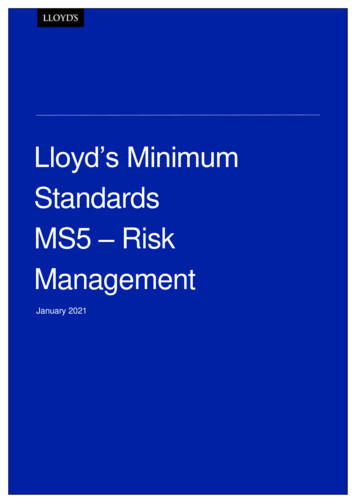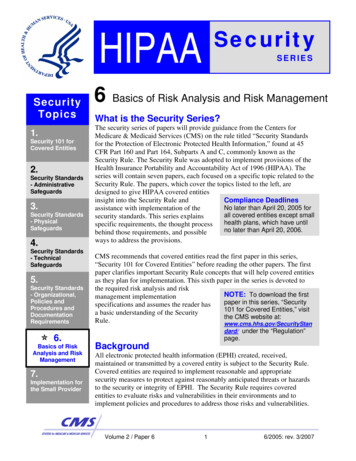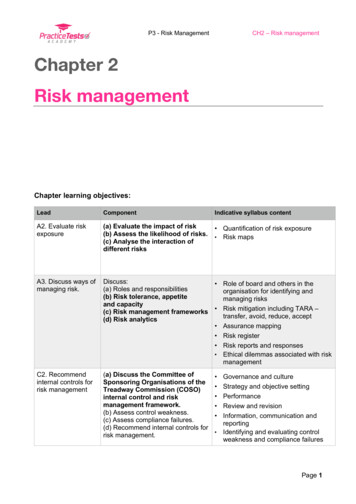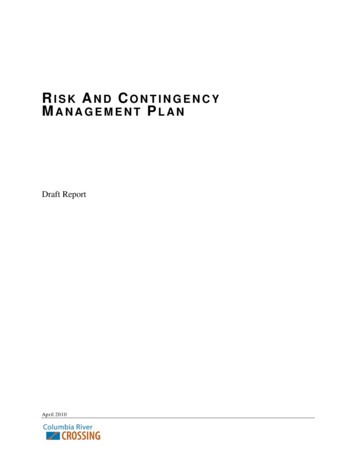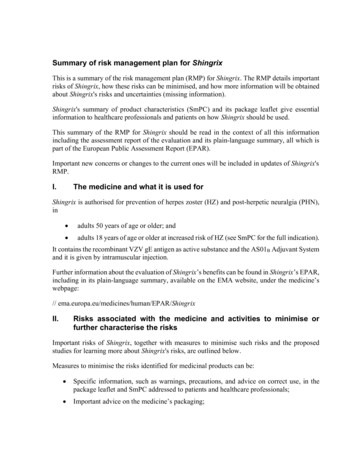
Transcription
Summary of risk management plan for ShingrixThis is a summary of the risk management plan (RMP) for Shingrix. The RMP details importantrisks of Shingrix, how these risks can be minimised, and how more information will be obtainedabout Shingrix's risks and uncertainties (missing information).Shingrix's summary of product characteristics (SmPC) and its package leaf let give essentialinformation to healthcare professionals and patients on how Shingrix should be used.This summary of the RMP for Shingrix should be read in the context of all this informationincluding the assessment report of the evaluation and its plain-language summary, all which ispart of the European Public Assessment Report (EPAR).Important new concerns or changes to the current ones will be included in updates of Shingrix'sRMP.I.The medicine and what it is used forShingrix is authorised for prevention of herpes zoster (HZ) and post-herpetic neuralgia (PHN),in adults 50 years of age or older; and adults 18 years of age or older at increased risk of HZ (see SmPC for the full indication).It contains the recombinant VZV gE antigen as active substance and the AS01B Adjuvant Systemand it is given by intramuscular injection.Further information about the evaluation of Shingrix’s benefits can be found in Shingrix’s EPAR,including in its plain-language summary, available on the EMA website, under the medicine’swebpage:// s associated with the medicine and activities to minimise orfurther characterise the risksImportant risks of Shingrix, together with measures to minimise such risks and the proposedstudies for learning more about Shingrix's risks, are outlined below.Measures to minimise the risks identified for medicinal products can be: Specific information, such as warnings, precautions, and advice on correct use, in thepackage leaflet and SmPC addressed to patients and healthcare professionals; Important advice on the medicine’s packaging;
The authorised pack size — the amount of medicine in a pack is chosen so to ensure thatthe medicine is used correctly; The medicine’s legal status — the way a medicine is supplied to the patient (e.g. with orwithout prescription) can help to minimise its risks.Together, these measures constitute routine risk minimisation measuresIn addition to these measures, information about adverse reactions is collected continuously andregularly analysed, including PSUR assessment so that immediate action can be taken asnecessary. These measures constitute routine pharmacovigilance activities.If important information that may affect the safe use of Shingrix is not yet available, it is listedunder ‘missing information’ below.II.AList of important risks and missing informationImportant risks of Shingrix are risks that need special risk management activities to furtherinvestigate or minimise the risk, so that the medicinal product can be safely administered.Important risks can be regarded as identified or potential. Identified risks are concerns for whichthere is sufficient proof of a link with the use of Shingrix. Potential risks are concerns for whichan association with the use of this medicine is possible based on available data, but thisassociation has not been established yet and needs further evaluation. Missing information refersto information on the safety of the medicinal product that is currently missing and needs to becollected (e.g. on the long-term use of the medicine);List of important risks and missing informationImportant identified risks NoneImportant potential risks Risk of potential Immune Mediated Disorders (pIMDs)following Shingrix vaccination) Guillain-Barré syndrome (GBS) Virus reactivation in individuals with a history of HerpesZoster Long-term efficacy and assessment of the need foradditional doses of the vaccine in adults of 18 years ofage or above Long-term immunogenicity in adults as of 18 years ofage or above Effectiveness of Shingrix in preventing HZ, PHN andother HZ-related complicationsMissing information
II.BSummary of important risksImportant potential risk: Risk of potential Immune Mediated Disorders (pIMDs) followingShingrix vaccinationEvidence for linking the risk tothe medicinepIMDs are a subset of adverse events that include autoimmunediseases and other inflammatory and/or neurological disorders ofinterest which may or may not have an autoimmune aetiology.pIMDs are considered as a theoretical risk for all vaccines containingAdjuvant Systems (i.e. adjuvant combinations). In addition to geneticfactors, environmental triggers (in particular, viruses, bacteria andother infectious pathogens) could play a major role in thedevelopment of pIMDs. This has stimulated the debate as towhether such diseases might also be triggered by vaccines,particularly based on their possible effects on the regulation of theimmune system and the potential (yet theoretical) concern that theymay induce unwanted immune processes in susceptible individuals.Case reports of autoimmune diseases temporally associated withthe administration of vaccines (both adjuvanted and non-adjuvanted)have been described in the scientific literature. Most of these reportsrefer to vaccines targeting viral illnesses. Proposed mechanisms bywhich vaccines might induce autoimmune diseases are frequentlyextrapolated from the known capacity of the infectious agents thatthe vaccine targetsRisk factors and risk groupsNaturally occurring autoimmune diseases are multi-etiologicalconditions with multiple risk factors, including genetic predisposition.All ages are affected with onset from childhood to late adulthood, aswell as all racial, ethnic and socioeconomic groups.No specific trend in terms of groups or risks factors has beenidentified in Shingrix.Risk minimisation measuresNo risk minimisation measuresAdditional pharmacovigilanceactivitiesAdditional pharmacovigilance activities:Short study name: EPI-ZOSTER-030 VS US DB, EPI-ZOSTER-032VS US DBSee section II.C of this summary for an overview of the postauthorisation development plan.
Important potential risk: Guillain-Barré syndrome (GBS)Evidence for linking the risk tothe medicineA post-marketing observational study (draft manuscript) evaluatingthe risk of GBS following vaccination with Shingrix in adults aged 65years or older enrolled in the Medicare health insurance in theUnited States indicated an increased risk of GBS during the 42 daysfollowing vaccination estimated as 3.13 excess cases of GBS permillion doses administered. Some limitation and confoundingvariables of the study are presented by the authors. Other timevarying confounders such as potential changes in GBS risk overtime due to wild-type VZV reactivation are presented as unknown.Moreover, the increased risk was only detected after the first dose([RR post dose 1 of 9.30 (95% CI: 3.00-28.84)];[RR post dose 2 of0.22 (95% CI: 0.04-1.22)]) and has only been investigated inindividuals aged 65 years or older. It is worth noting that incidence ofGBS increases with age (1.65 per 100,000 py in 40-64 YOA; 3.33per 100,000 PY in 65-79 YOA and 3.07 per 100,000 PY in more than80 YOA). GSK has also explored the potential confounding role ofpreceding HZ episode(s) in the occurrence of GBS post vaccination,a self-controlled case series (SCCS) in two US claims databases(Truven Health Analytics’ Marketscan commercial ( 65 years old)and Medicare supplemental ( 65 years old), abstract submittedsuggests a confounding effect of HZ episodes on the potentialcausal association between Shingrix vaccination and the risk ofGBS. The possible temporal association between HZ disease andGBS has been reported in the literature.The review of additional data (including preclinical data, clinicalstudy data, the scientific literature, spontaneous report data in theGSK safety database and external databases such asEudraVigilance and VAERS), does not indicate that there is anincreased occurrence of GBS following vaccination with Shingrix.When considering 75% of reporting fraction the observed number ofcases was above the expected number of cases in Canada,however the expected was included in the 95%CI of the observed. InGermany, USA and worldwide the observed number of cases werebelow the expected, for several plausible scenarios of backgroundincidence rates and underreporting, based on background data froma 2007 publication. However, several limitations inherent to theavailable data are noted, e.g., possible underreporting or the qualityof the spontaneously reported cases (extent of documentation);clinical trials were not designed to evaluate an association betweenShingrix vaccination and rare diseases.Because of the substantial limitations of the currently available dataand confounding variables, the Company has concluded that the
strength of evidence of the overall data currently available to theCompany are insufficient to determine a causal relationship of GBSwith Shingrix.Risk factors and risk groupsIn North America and Europe, GBS is more common in adults, andthe incidence increases exponentially with age (1.65 per 100,000 pyin 40-64 YOA; 3.33 per 100,000 PY in 65-79 YOA and 3.07 per100,000 PY in more than 80 YOA).Approximately two-thirds of GBS cases occur several days orweeks after an apparent infectious illness, commonly agastrointestinal illness or upper respiratory tract infection.Campylobacter enteritis, influenza, cytomegalovirus, Epstein-Barrvirus, human immunodeficiency virus (HIV), chikungunya, Zikavirus, and Mycoplasma pneumoniae have been implicated to be thetrigger. Malignancies and surgical procedures also have beensuggested to this increase the risk of GBS.Risk minimisation measuresRoutine risk minimisation measures:Wording in SmPC section 4.4Additional pharmacovigilanceactivitiesAdditional pharmacovigilance activities:Short study name: EPI-ZOSTER-030 VS US DB, EPI-ZOSTER-032VS US DBSee section II.C of this summary for an overview of the postauthorisation development plan.Important potential risk: Virus reactivation in individuals with a history of Herpes ZosterEvidence for linking the risk tothe medicineZOSTER-033 was a phase 3 open-label, uncontrolled, study whichevaluated the safety and immunogenicity of Shingrix whenadministered IM on a M0/M2 schedule to 96 subjects with a priorphysician-documented history of HZ. The occurrence of HZ was notan endpoint of the study; HZ was to be reported as an AE or SAE asapplicable. Six subjects (6.3%), two of whom had reported morethan one prior episode of HZ (1 participant with 2 episodes and 1participant with 3 episodes), reported nine episodes of unconfirmedHZ during the study period of M0 – M14. None of these suspectedHZ cases were considered related to vaccination by the investigator.Five of the subjects received anti-viral medication. Clinical detailswhich would inform a robust conclusion regarding these events arelacking. As the study was not designed to formally evaluate HZrecurrence (uncontrolled study with a limited sample size and no HZconfirmatory testing), conclusions regarding this aspect of the study
have to be considered with caution, in particular since some caseswere self-reported.In ZOSTER-056, from the 292 subjects with previous HZ, who hadreceived placebo during the ZOSTER 006/022 pivotal studies andsubsequently received HZ/su vaccination in ZOSTER -056, only onesubject had a clinically confirmed episode of HZ, the episodeoccurred between Dose 1 and Dose 2 of study vaccination.In post marketing setting, reported HZ episodes in subjects with aprevious history of HZ do not suggest a safety concernRisk factors and risk groupsSubjects with a history of a previous Herpes Zoster. Only peoplewho had natural infection with wild-type VZV or had varicellavaccination can develop herpes zoster. The reasons why VZVreactivates and causes herpes zoster are not well understood.However, a person’s risk for herpes zoster may increase as theirVZV-specific cell-mediated immunity declines. This decline inimmunity can result from increasing age and/or medical conditionsand medications that suppress the immune system. A person’srisk for herpes zoster increases sharply after 50 years of age.Risk minimisation measuresRoutine risk minimisation measures:Wording in SmPC sections 4.4 and 5.1Additional pharmacovigilanceactivitiesAdditional pharmacovigilance activities:Short study name: ZOSTER-062See section II.C of this summary for an overview of the postauthorisation development plan.Missing information: Long-term efficacy and assessment of the need for additional doses inadults 18 years of age and olderRisk minimisation measuresNo risk minimisation measuresAdditional pharmacovigilanceactivitiesAdditional pharmacovigilance activities:Short study name: ZOSTER-049See section II.C of this summary for an overview of the postauthorisation development plan.
Missing information: Long-term immunogenicity in adults 18 years of age and olderRisk minimisation measuresNo risk minimisation measuresAdditional pharmacovigilanceactivitiesAdditional pharmacovigilance activities:Short study name: ZOSTER-049, ZOSTER-073See section II.C of this summary for an overview of the postauthorisation development plan.Missing information: Effectiveness of Shingrix in preventing HZ, PHN and other HZ-relatedcomplicationsRisk minimisation measuresNo risk minimisation measuresAdditional pharmacovigilanceactivitiesAdditional pharmacovigilance activities:Short study name: EPI-ZOSTER-031See section II.C of this summary for an overview of the postauthorisation development plan.II.CPost-authorisation development planII.C.1Studies which are conditions of the marketing authorisationThere are no studies which are conditions of the marketing authorisation or specific obligationof Shingrix.II.C.2Other studies in post-authorisation development planStudy short namePurpose of the studyZOSTER-049To investigate long term efficacy, safety andimmunogenicity, as well as to assessreactogenicity, safety and immunogenicity of oneor two additional dosesLong-term efficacy and assessment of the needfor additional doses in adults 50 years of age andolder(Category 3)EPI-ZOSTER-030 VS US DBTargeted safety study (TSS to evaluate the safetyof Shingrix in adults 50 years of age in the U.STo evaluate the safety of Shingrix in older adults( 50 YOA) in the US.(Category 3)EPI-ZOSTER-032 VS US DBTargeted safety study (TSS to evaluate the safetyof Shingrix in adults 65 years of age in the U.STo evaluate the safety of Shingrix in older adults( 65 YOA) in the US
Study short namePurpose of the study(Category 3)ZOSTER-062Immunogenicity and safety study of Shingrix on atwo-dose schedule in adults 50 years of agewith a prior episode of Herpes ZosterTo assess safety, immunogenicity andreactogenicity of Shingrix in subjects with aprevious history of Herpes Zoster.(Category 3)EPI-ZOSTER-031Effectiveness of Shingrix in preventing HZ, PHNand other HZ-related complication(Category 3)ZOSTER-073Long term immunogenicity study and assessmentof revaccination with 2 additional doses in adultrenal transplant participants from ZOSTER-041To estimate the effectiveness of Shingrix inpreventing HZ, PHN and HZO in US subjectsaged 50 years and above, overall and by agegroups.To estimate long-term vaccine effectiveness up to10 years after vaccination with Shingrix.To evaluate long term immunogenicity and safetyas well as reactogenicity, safety andimmunogenicity of revaccination with twoadditional doses in adult renal transplant subjectsfrom the study ZOSTER-041.
(Truven Health Analytics' Marketscan commercial ( 65 years old) and Medicare supplemental ( 65 years old), abstract submitted suggests a confounding effect of HZ episodes on the potential . GSK safety database and external databases such as EudraVigilance and VAERS), does not indicate that there is an .


